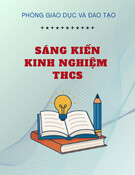EXPERIENCE INITIATIVE SOME SUGGESTED GRAPHIC ORGANIZERS TO ENHANCE ENGLISH SPEAKING ABILITY FOR 10TH GRADE STUDENTS LEARNING GLOBAL SUCCESS TEXTBOOK IN TAN KY HIGH SCHOOL.
(Subject: English teaching)
i
MINISTRY OF EDUCATION AND TRAINING
VINH UNIVERSITY NGHE AN DEPARTEMENT OF EDUCATION AND TRAINING TAN KY HIGH SCHOOL ----------
----------
PHẠM THỊ DUNG
EXPERIENCE INITIATIVE SOME SUGGESTED GRAPHIC ORGANIZERS TO ENHANCE ENGLISH SPEAKING ABILITY FOR 10TH GRADE STUDENTS LEARNING GLOBAL SUCCESS TEXTBOOK IN TAN KY HIGH APPLYING SCAFFOLDING TECHNIQUES TO ENHANCE EFL SCHOOL. 11TH GRADERS’ SPEAKING ABILITY
(Subject: English teaching)
MASTER’S THESIS IN EDUCATION
Major: Teaching English to Speakers of Other Languages (TESOL)
Code:
Researchers Phạm Thị Dung Võ Thị Hồng Quyên Phone number: 0941564189 - 0912830528 ( FOREIGN LANGUAGE GROUP)
Supervisor’s name
NGUYỄN XUÂN BÌNH
Nghe An 2023
ii
TABLE OF CONTENTS
TABLE OF CONTENTS ..................................................................................... iv
LIST OF ABBREVIATIONS .............................................................................. vi
PART I. INTRODUCTION .................................................................................. 1
1.1. Rationale for the study ............................................................................... 1
1.2. The purpose of the study ............................................................................ 1
1.3. The scope of the study ................................................................................ 2
1.4. The significance of the study ..................................................................... 2
PART II. CONTENT ............................................................................................ 3
2.1. Overview of speaking skill......................................................................... 3
2.1.1. Definition of speaking. ........................................................................ 3
2.1.2. What is teaching speaking? ................................................................. 3
2.1.3. Approaches to teaching speaking ........................................................ 3
2.1.4. How to teach Speaking ........................................................................ 4
2.1.5. Several types of speaking performance: ............................................. 5
2.1.6. Technique of Teaching Speaking ........................................................ 5
2.1.7. The difficulties learners meet when learning speaking. ..................... 7
2.2. Overview of graphic organizers. .............................................................. 10
2.2.1. The definition of graphic organizers ................................................. 10
2.2.2. The kinds of graphic organizers ........................................................ 11
2.2.3. The benefits of graphic organizers in teaching speaking skill .......... 12
2.2.4. The steps of applying graphic organizers ......................................... 13
2.3. The study .................................................................................................... 14
2.3.1. The setting of the study. ........................................................................ 14
2.3.1.1. The current issues of teaching and learning speaking skill for 11th
graders at Tan Ky High school.................................................................... 14
2.3.1.2. Participants ..................................................................................... 14
2.3.2. Research questions. ............................................................................... 14
2.3.3. Research methodology. ....................................................................... 14
iii
2.3.4. Applying graphic organizers into teaching speaking skill for EFL 10
graders ............................................................................................................... 17
2.3.5. Findings and avaluation ........................................................................ 24
2.3.5.1. Data analysis and discussion from tests. ............................................ 25
2.3.5.2. Data analysis from pre-survey questionnaire. .................................... 28
PART III: CONCLUSION .................................................................................. 31
3.1. Conclusion. ............................................................................................... 33
3.2. Limitations and suggestions for further studies. ...................................... 33
REFERENCES .................................................................................................... 35
APPENDIX ......................................................................................................... 36
iv
LIST OF ABBREVIATIONS
1 EFL: English as Foreign Language
2 ESL: English as Second Language
3 FL: Foreign Language
v
PART I. INTRODUCTION
1.1. Rationale for the study
Along with the globalization trend, English becomes an important subject in the curriculum of both state schools and private ones from primary schools to universities in Viet Nam. In this context, the teaching and learning of English is considered as a significant duty for Ministry of Education and Training as well as all teachers of English. In recent years, teaching and learning English as a foreign language has gained considerable progress both in scale and quality. However, there is still a gap in English teaching and learning outcomes between rural and urban areas. The fact is that the teaching and learning of English has not been effective in rural areas yet. One of the differences between the learners in cities and rural areas is the learners‟ ability to speak English. There are still many people learning at rural areas cannot use English well after finishing English courses. Tan Ky, a remote and mountainous area, belongs to one of the rural areas of Nghe An where the learners‟ speaking skill is much limited. This problem comes from many different causes, including objective and subjective reasons.
According to Brown and Yule (1983), speaking is the skill that the students will be judged upon most in real-life situations. It is an important part of everyday interaction and most often the first impression of a person is based on his/her ability to speak fluently and comprehensively. So, teachers have a responsibility to prepare the students as much as possible to be able to speak in English in the real world outside the classroom. Despite its importance, for many years, teaching speaking has been undervalued and English language teachers have continued to teach speaking just as a repetition of drills or memorization of dialogues. However, the world now requires that the goal of teaching speaking should improve students' communicative skills, because, only in that way, students can express themselves and learn how to follow the social and cultural rules appropriate in each communicative circumstance.
As a teacher of English at a rural upper secondary school, the researcher is concerned about her students‟ English learning, especially, in speaking skill. She has been teaching 2 classes of grade 10. Although her students have learnt English since they were in grade 3 with the new syllabus and new methods applied with the communicative approach, their spoken English in the real world is still restricted . They hardly use English to communicate for fear of making mistakes, lack of vocabulary, wrong pronunciation and others. So the question is put for the researcher what teachers should do to help their students learn spoken English better in this rural environment, where the English language input is poor and the chances to practice spoken English are limited. The researcher has thought a lot about this fact and decided to conduct the study on “Some suggested graphic organizers to enhance English speaking ability for 10th grade students learning
1
global success textbook in Tan Ky High school.”. The researcher implements this study with the hope to find out a suitable method to improve the learners‟ speaking skill in real life at local.
1.2. The purpose of the study
This study aims at suggesting some adaptations using graphic organizers in teaching speaking skill in textbook English 10 - global success.
1.3. The scope of the study
The study was carried out at Tan Ky High School with the total of students relating to 80 EFL 10th graders who come from class 10d4 and class 10d5 of Tan Ky High School. The learners are divided into two groups, the control group and the experimental group. The study is aimed to investigate the effectiveness of graphic organizers in teaching speaking skill as well as the learners‟ attitude toward this technique. The time for studying lasts from the September 2022 to March, 2023.
1.4. The significance of the study
The thesis provides for ESL teachers the deeper understanding of applying graphic organizers in teaching speaking skill. The study will be the significant source of reference for ESL teachers at rural areas. In addition, the study will supply for the ESL teachers at Tan Ky district the new approach to apply graphic organizers in teaching. The result of the study is believed to make a great contribution to the success of teaching speaking skill in common.
2
PART II. CONTENT
2.1. Overview of speaking skill.
2.1.1. Definition of speaking.
According to Longman Dictionary, speaking is the utterance of intelligible speech or seeming to be capable of speech. Speaking is the process of orally expressing thought and feelings of reflecting and shaping experience, and sharing information. Speaking is a complex process, which involves thinking language and social skills. The speaker combines words to sentences and paragraphs and use a language style that is appropriate to a social context. Speaking is developing for the relationships between a speaker and her hearer. In addition, speaking is determining which logical linguistic, psychological and physical rules that should be applied in a given communicative situation
Tarigan (1990:3-4) defines that speaking is a language skill that is developed in child life, which is produced by listening skill, and at that period speaking skill is learned.
2.1.2. What is teaching speaking?
Teaching speaking is to teach our learners to:
- Produce the English speech sounds and sound patterns.
- Use word and sentence stress, intonation patterns and the rhythm of the second language.
- Select appropriate words and sentences according to the proper social setting audience, situation and subject matter.
- Organize their thoughts in a meaningful and logical sequence.
- Use language as a means of expressing values and judgments.
- Use the language quickly and confidently with few unnatural pauses, which is called as fluency (Nunan 2003).
2.1.3. Approaches to teaching speaking
According to the theories of first and second language, Thornberry (2005; see also Leighton & Spade, 2006; Brown 2007) refers three theories of language learning relating to the speaking teaching. They are behaviorist, cognitive and socio-cultural theory.
According to behaviorist, language is learned by “forming good habits through reinforcement” (Thornbury, 2005, p.38). The process of learning speaking follows presentation, practice, controlled production. The major purpose of the process is to form automatic habits. Firstly, EFL learners listen to teacher or a tape, videos. Then, they practice by drilling, retell, show and tell, etc. Finally, learners perform their product in front of the class.
3
According to cognitivists, learners‟ minds are expected as black boxes with the capacity of information processing. Speaking skill is examined to be developed through learning stages that range from being controlled to automatic. Learning first pays attention to awareness-raising of specific stages of a procedure, then changes to integrate the newly acquired knowledge and existing knowledge through practice and ends with self-controlling.
In sociocultural theory, Thornbury (2005) and Lightbown & Spada (2006) states that the socio-cultural situation is significant in learning and they also express that learning is conducted through social interaction and with other learners. Learners need to have other-regulation, mediation of somebody who has better knowledge and can provide a supportive framework which can be like scaffold. Learners interact with partners, teachers etc and the interaction permits them to build new knowledge until they gain the appropriate level. They turn the knowledge into their own and can act themselves.
2.1.4. How to teach Speaking
language
Many linguistics and ESL teachers agree that EFL learners acquire speaking skill by "interacting". Communicative learning and collaborative learning meet the best for purpose. Communicative language learning focuses on real-life situations through communication. Using this method in ESL classes, learners will have chance to communicate in the target language. Teaching speaking skill covers three main periods including pre-, while and post speaking.
Pre-Speaking Stage: Regina, Sik (1997) stated that pre-speaking stage is a period for planning and organizing. Pre-speaking stage is conducted firstly with the aim to preparing the learners‟ knowledge background. Through pre- speaking activities, learners‟ thought, reflection and experience are stimulated. This stage also includes supplying new knowledge, vocabulary and structures.
While- Speaking Stage: In this period, the learners have to practice the new language in controll. The teacher can use the activities such as: repetition or drill, show and tell, running dictation, surveys, picture description, interview, sentence auction, etc. Learners work in collaborative environment in pairs, groups or teams.
Post- Speaking Stage: The aim of this period is to help EFL learners to summarize what they have learned. In this period, learners do activities such as: making eloquence, role-play, picture description, interview, competition games, drama games, reporting…etc. According to Regina, Sik (1997), the post-speaking period is a time when EFL learners have chance to reflect upon their own speaking performance. Peer comment should be encouraged in this stage. Moreover, feedback needs to construct to encourage and avoid making unconfident for learners in the future.
4
2.1.5. Several types of speaking performance:
Imitative
Imitative is a term in teaching speaking that refers to the learners working like a parrot to repeat exactly the sounds of a word, a phrase or even a sentence.
This performance mostly focuses on phonetic level. It is not exercised for the purpose of communication. The activity in this kind of performance is often drilling
Intensive
This type of performance is used after imitative step to carry out many kinds of speaking performance relating to grammatical and lexical aspects in learning a foreign language.
Responsive
The learners reply to the questions, comments in a meaningful way. The tasks in this kind are often making a short conversation, greetings, …
Transactional
This type of performance is only used in the dialogue. It is carried out for the purpose of exchanging detail information
Interpersonal
This type of performance is also used in the dialogue. It is carried out to maintain social communication relating to slang, ellipsis, etc and it makes the learners difficult to understand and catch up the meanings.
Extensive
This type of performance is used in monologue having form of oral summaries, short speeches or reports. This type of performance is advised to use for advanced level.
2.1.6. Techniques of Teaching Speaking
Role Play
One way of getting students to speak naturally is role play activity. Learners imagine they are in different social contexts and experience many social roles. During the activity, the learners have to work as the person that they play the role of and make response to what that person thinks or feels.
Simulations
Simulations seem similar to role-plays but simulations are more elaborate. In simulations, learners have to bring items to the class to create a realistic environment. For instance, if a learner is working as a singer, she must bring a microphone to sing. Role plays and simulations have many advantages because 5
they are entertaining and they motivate the learners. According to Harmer, role plays and simulations increase the self-confidence for hesitant learners because in role play and simulation activities, learners will have a different role and do not have to speak for themselves, which means learners do not have to take the same responsibility (1984).
Information Gap
In this activity, learners are supposed to work in pairs. One student has the information that the rest does not have, then the two partners will communicate to fill the information. This activity assists to collect information in a natural way and suits with the communicative approach of teaching method. Information gap is effective because everyone in class has the opportunity to express extensively in the target language.
Brainstorming
When having a topic, learners will produce ideas in a limited time. The learners can work individually or group to generate ideas quickly. The best characteristic of brainstorming is that the learners are not criticized for their ideas so they will be open to share new ideas.
Storytelling
Learners briefly summarize a story they heard from somebody before, or they can imagine their own stories to tell their classmates. Story telling fosters creative thinking and helps learners express their ideas in the format of beginning, development, and ending, including the characters and setting of a story. Learners also tell riddles or jokes. For example, the teacher can call some students to tell short funny stories or jokes as an interesting opening of the lesson. By this way, not only will the teacher enhance learners‟ speaking ability, but also draw the attention of the whole class.
Interviews
In this activity, learners implement interviews with various people. To attain the good result, the teacher should provide a rubric for learners in order to help them know what type of questions they can ask or what path to follow in each detailed context. However, learners should prepare their own interview questions. Interview activity gives learners a chance to practice their speaking skill not only in class but also outside and helps them become more socialable. After interviews, learners present their products to the class.
Story Completion
Learners sit in a circle or many small circles. In this activity, the teacher starts by telling a story, but after a few sentences the teacher stops narrating. Then,
6
each learner add from four to ten sentences to develop the story. Learners have to add new characters, events, descriptions, …etc to create a meaningful story.
Reporting
Before coming to class, learners are asked to read a newspaper or magazine and at the class, learners have to report what they find as the most interesting news. Learners can also discuss about what they experienced something worth or tell their classmates their daily routines before coming to class.
Playing Cards
Each student in a group will choose a card and write 4-5 questions about the topic to ask the other people in the group. The questions must not be yes-no questions, because yes-no questions bring little chance to practice spoken language. Students are encouraged to ask open-ended questions and the response is hoped to be more significant.
Picture Describing
Using pictures in a speaking activity is to give students a picture and let them describe what they see in the picture. In this activity, students can act in groups or pairs. The picture may be the same or different. Students discuss the picture with their groups or pairs, then a learner representing for each group describes the picture to the whole class. This activity does not only foster the learners‟ imagination and creativity but also improves their natural speaking skills.
Find the Difference
In this activity, learners work in pairs and each pair is given two different pictures. For instance, a student gets a picture of a village and another student gets a picture of a city. They work together to find out the similarities or the differences between the pictures.
Discussions/Debates
Learners work in groups to discuss a topic in a limited time. In this activity, students must work to develop a plan, resolve a problem, or complete a task.Teacher should arrange each group with a gifted student, which makes the competitive atmosphere among the groups. Moreover, the members of each group can help each other to make progression for learners who are weaker at learning. It is also important that the expression should be divided equally for all members in group.This activity well creates both critical thinking and making decision because of its characteristics. The teacher is advised to rearrange the groups in other lessons which give the learners the chance to work with various friends.
2.1.7. The difficulties learners meet when learning speaking.
Pronunciation.
7
Nation (2009.p.75) stated, "When some teachers and students complain about difficulties in speaking, they are often talking about pronunciation”. Pronunciation actually brings a lot of difficulties for Vietnamese teachers who teach English, especially teachers in remote areas. However, pronunciation is really important in speaking. Derwing and Munro (2005) shared that, "having good pronunciation of the language can help in normal communication, particularly intelligibility". There are four major factors that cause problems for learners when they pronounce English. Firstly, the complexity of tense and lax vowels in English creates large confusion for most of learners. Secondly, a variety of dialect differences and consonant positions also cause confusion. Consonant clusters also lead speakers to make mistakes when speaking English. Finally, the stress in the words varies irregularly which make learners difficult to communicate.
Fear of mistake.
Most of learners when learning speaking English face up with the fear of making mistakes. Their fears come from being laughed at by other learners or being criticized by teachers. As a result, learners tend to stop participating in the speaking activities at class. Therefore, it is necessary for teachers to explain to their students that making mistakes is not a big problem because learners can learn themselves from their mistakes.
Shyness.
Shyness is an emotional body‟s response that many learners suffer from when they act something in front of a crowd as well as speak English in front of class. As a result, shyness is a source of problem during learning, especially in speaking class. Therefore, paying attention to this factor plays an important role to help learners do their best in learning speaking skill. Baldwin (2011) explained that making a speech in front of a large crowd is one of the common phobias that learners sometimes fall in shyness which makes their mind go blank and they forget what to say. Understanding this, teachers will have way to help learners overcome their shyness by creating a friendly and open environment in the class. By doing this, shy learners will feel confident and sympathetic with the mistakes they make during their learning. Solving the shyness problem, Chinmoy (2007) suggests that in order to help learners be more confident in their speaking, teachers should convince learners to look upon shyness as a thing to overcome and do not feel fear of failure or success. Failure is considered as the mother of success.
Anxiety.
According to Horwitz et, anxiety is a phenomenon of tension, apprehension and nervousness associated with the situation of learning a foreign language (Nascente, 2001). Nascente also expresses that anxiety stands out as one of the main blocking factors for effective language learning compared with other affective variables. In other words, anxiety influences learners during their learning
8
language. Therefore, when teaching speaking, this factor need be taken into consideration. Anxiety influences the quality of oral language production and makes individuals appear less fluent than they really are, which suggests that teachers have to try to make an attempt to create a comfortable learning atmosphere with interesting activities.
Lack of Confidence
Learners‟ lack of confidence often occurs when they realize that their cooperation with their classmates does not bring effectiveness. It means that they present their ideas or topics without receiving positive response from their classmates and teachers. If this situation happens repeatedly, learners will keep silent during the next periods of the speaking lessons. Another main cause of learners‟ low self-esteem and confidence is learners‟ poor ability in speaking English and the lack of encouragement from the teacher. So encouragement plays a vital role in building learners‟ confidence.
Lack of motivation
Motivation is considered as a key to learners‟ learning success. Motivation is an important factor that affects learners‟ energy to speak in English. Learners with a strong motivation can succeed persistently in learning and gain better result than those who have weaker motivation. Gardner in Nunan(1999) explains the causes of learners „ lack of motivation are uninspired teaching method , boredom, lack of perceived relevance of materials, lack of the goals of the instructional program. According to him, uninspired teaching affects much to learners‟ motivation of learning. He also adds that monotonous teaching reduces learners‟ motivation because of the feeling of boredom. Babu (2010) argues that lack of motivation in learning causes learners‟ hesitation in speaking English in classrooms. To solve this problem, teachers must have passion, creativity and interest in teaching. In other words, learners‟ motivation is strongly influenced by teachers‟ performance and passion. Therefore, teachers should show enthusiasm during their teaching work.
Class size and material
The number of learners in a classroom is a factor that the teacher needs to take in to consideration when conducting a lesson plan. In this respect, Mayer (2000, p. 31) claims "that the way teachers implement the course content, instructional pedagogy, and technology used in the classroom may all be influenced by the number of students in the class". He considers that students learn much better in small classes because the teacher is able to use techniques and pedagogy effectively.
About materials, materials are considered to be among the most important tools that a teacher can use in class in order to make the teacher‟s lectures smoothly and be effective in transmitting the necessary knowledge to all learners. 9
Materials is regarded a useful means to motivate learners, arouse their interest and expose them to the real language they will face in the real world.
Limited vocabulary.
Vocabulary is one of the most important parts in teaching and learning a foreign language. It is the key for the development of all other skills in learning English. Vocabulary is considered as a main tool for learners in attempt to own a foreign language effectively. People can use words to express their ideas, thought, feeling and ... etc in most situations to get the target communication. For example, to buy something in a store, you just need to say the word relating to that item, you still buy it without difficulties. However, there is the fact that learners usually find it difficult to speak English in most real situations in life. They usually find speaking exhausting and they only use the same expressions and words so that their speech is stopped soon. Many learners are confronted with the problem of forgetting the words immediately or use the words which cause confusion of meanings. Therefore, the more words learners have, the easier they communicate.
2.2. Overview of graphic organizers.
2.2.1. The definition of graphic organizers
The idea of graphic organizers has its root in Ausubel‟s theory of a meaningful learning (1960)(Maryam Heidarifard 2014). Graphic knowledge, also called the structured overview,was developed by Barron(1969) and based on the concept of the advance organizer of Ausubel(1968). A fundamental concept in Ausubel „s (1963)cognitive psychology was that learning takes place by assimilating new concepts and prepositions into learner‟s existing conceptual frameworks. Learning new knowledge is based on the learner‟s prior knowledge; he also believes that meaningful learning takes place when new information is linked to the learner‟s prior knowledge in a non-arbitrary and substantive way (chiu-ling chiang 2005). According to Ausubel‟s cognitive theory of meaningful verbal learning, the use of advance organizers enhances students‟ learning and retention of unfamiliar but meaningful materials (Ausubel, 1960). He assumed that the new information is acquired when it is linked to the learners‟ already existing cognitive structure (1968). Therefore, the purpose of the organizer is to activate students‟ prior knowledge and relate the new material to the previously stored information providing optimal anchorage and rendering the new material more familiar and meaningful (Ausubel, 1960), which is consistent with the schema theory (Anderson & Pearson, 1984). According to the schema theory, our mind is composed of cognitive structures (schemata) of knowledge, known as prior or background knowledge, which accept and assimilate the newly acquired information in order to enhance learning and retention of information. One has comprehended a text when s/he has found a “mental home” for the information in the text or has altered an existing one in order to accommodate the new knowledge
10
(Anderson & Pearson, 1984). The application of graphic organizers developed from pre-reading comprehension activities to reading and post reading ones (Maryam Heidarifard). Applying graphic organizers to many subject area and age levels, researchers have obtained strong piece of evidence for effectiveness of this technique (Dye, 2000).
2.2.2. The kinds of graphic organizers.
Graphic organizers come in many different forms, each one best suited to organizing a particular type of information
According to Meyer‟s (1985) classification, expository text structures include:
1. Description: The author describes a topic
2. Sequence: The author uses numerical or chronological order to list items or events
3. Compare/Contrast: The author compares and contrast two or more similar events, topics, or objects.
4. Cause/effect: The author delineates one or more causes and then describes the ensuing effects
5. Problem/solution: The author poses a problem or question and then gives the answer.
Besides the above structures, Mohan (1986) added more structures as definition,
classification, argument- reasoning, and for- against. Jiang and Grabe (2007) suggested a set of standardized easily-drawing samples shown these diagrams
Network tree
Spider Map
11
Problem and solution map
Sequential Episodic Map
Fishbone Map
2.2.3. The benefits of graphic organizers in teaching speaking skill.
Graphic organisers have multiple uses. They can be used to structure writing projects, summarise reading texts, organise and store vocabulary, and help in problem solving, decision making, studying, planning research and brainstorming.
While organisers often represent an individual's arrangement of information, they can also be used at group or class levels. A class flow-chart of the storyline may help all the students to follow the plot.
Since most graphic organisers use short words or phrases, and sometimes drawings, they can be used with all levels and with young and less-able learners.
12
The teacher is given a record of the learner's thinking process. Graphic organisers can be used to assess students' knowledge and understand of the content, thinking skills and creativity.
In speaking skill, graphic organizers make the study more enjoyable and efficient by showing the relationship, visualizing and simplifying ideas, and organizing information. Graphic organisers also provide the learner with a different way of seeing and thinking about information. Language barriers (words, grammar) are removed, so that learners can focus on the connections between information. Moreover, in most cases, dual-presentation or visual representation plus is more successful than either approach alone. Last but not least, analytical, critical, planning and creative thinking skills are developed. To create the map, the learner has to identify the relationships between items, examine the meanings attached to them, and prioritise the information and decide where each item should be placed on the map. Students are more likely to become strategic learners when talking. A structure, graphic display can also be converted into a lot of information. A large amount of information can be an be provided after looking graphic organizers so that it helps students gain the length of the talk. Creating the map helps the learner to generate ideas and see the possibilities associated with a topic as the map grows.
2.2.4. The steps of applying graphic organisers.
Learners need to be trained to use graphic organisers and it is the teacher's job to introduce them gradually and systematically, beginning with simple mind maps to brainstorm topics and charts to provide a purpose for the topic learners are going to talk.
Typically, followed in these stages:
The teacher constructs the graphic organiser, provides students with a copy, and tells them how and when to complete it.
The teacher and students co-construct graphic organisers showing important ideas as the content is explored.
Teams of students construct graphic organisers cooperatively with the teacher acting as a guide.
The students construct graphic organisers independently.
In the early stages, it is a good idea for the teacher to keep a selection of organisers at hand so that learners have a choice and can experiment with a wider range of designs.
Graphic organisers are as useful for teachers as they are for learners. They are a valuable tool in lesson planning, syllabus design, report writing and research as well as providing an insight into the individual learner's thought processes and learning style.
13
2.3. The study
2.3.1. The setting of the study. 2.3.1.1. The current issues of teaching and learning speaking skill for 10th graders at Tan Ky High School.
Using English to communicate in real life, 10th graders at Tan Ky High School meet a lot of difficulties. They usually feel insecure about their level of English and they face problems communicating as well as expressing themselves in the target language. They also have little knowledge background, vocabulary and grammar. As a result, they remain silent as they are in fear of making mistakes and do not show active participation in speaking lessons. This poses for teachers to integrate, to teach students how to put knowledge into practice, to apply interdisciplinary knowledge to solve practical situations.
2.3.1.2. Participants
Eighty EFL learners who participate in the study come from a rural local of Nghe An, which means their ability in English is not good, especially in speaking skill. Their age is sixteen and forty five learners are female, account for more than fifty six percent. They come from two classes of Tan Ky High School. 40 students come from class 10d4 and the rest come from class 10d5. The researcher divides them into two groups. The learners coming from class 10d4 belong to the experimental group and the learners coming from class 10d5 belong to the controll group. All of the surveyed learners have learned English for at least four years at secondary schools. However, most of them can not do grammar well as well as mastering four language skills. And in fact, of the four language skills, as many of learners revealed, they find speaking the most challenging. There are few students who can speak English fluently. Most of them hardly say a phrase or a sentence in English relating to the surroundings where they live. Moreover, the psychology of learners in rural areas is uncomfortable and confident when they speak a foreign language. Last but not least, the knowledge about the topic is sometimes exhausting to learners, which makes a big drawback for EFL learners to use English when speaking.
2.3.2. Research questions.
In order to meet the abovedmentioned objectives, the research is focused to answer the following questions:
1. What are students‟ attitudes towards graphic organizers in learning speaking skill?
2. Do graphic organizers improve students‟ EFL speaking ability? If so, to what extent?
2.3.3. Research methodology.
14
Data collection instruments
In order to achieve accurate research results, the data collection methods used in this research was aimed to collect both quantitative and qualitative data to take advantages of analytical-monological and exploratory interpretive paradigms in applied linguistics (Nunan, 1996). The quantitative data were collected from pre and post tests with the total of more than …questions and were analyzed statistically whereas the qualitative data were concluded from the structured interview and class observation. Five main elements of speaking progress are paid attention to are: Vocabulary, grammar, fluency, length and comprehension.
Questionnaires.
For the purpose of data collection, a set of questionnaire for pre-survey and post- survey was designed to discover the participants‟ motivation, method, ..etc in learning speaking skill. At the beginning of the study, the questionnaire was designed to gather EFL learners‟ and teachers‟ opinion on the speaking skill as well as their using English daily. The questions are short, simple and easy to understand. The participants were required to answer the questions by circling the appropriate scales to determine their awareness. After some months of being treated, students and teachers are asked to give their personal opinion regarding the graphic organizers and their progress. The questionnaires usefully helped the writer evaluate exactly the changes in learning and teaching work relating to graphic organizers.
Observation.
Observation was another research instrument to examine the EFL students‟ participation and progress. Since different students develop their speaking skill in different ways, it was difficult to capture the EFL learners‟ progress through questionnaires interviews. Therefore, observations provided precious information needed in the study. Through observations I realize that every EFL student gets improvement if they take part in the study. Some learners speak more naturally, others are more confident when communicating or expressing, others get the numerous vocabulary. And above all, most of the EFL learners are active and enthusiastic at introducing their local places.
Test.
The author applied both pre- test and post-test in the study. The pre-test assisted the author to appreciate the learners‟ level, knowledge, attitude and method in learning. The post-test was applied in the last period of the study to evaluate the progress of the learners‟ after being treated with scaffolding technique. The score of the test is base on five criterions: Lexical resource, fluency, pronunciation, grammatical range and accuracy and comprehension.
15
The researcher had learners‟ score based on the rubric created by the teacher following the above website. The learners‟ score was calculated by the formula:
The total of 5 criteria
Learner‟s score = ------------------------------ x 10
Maximum scores
To appreciate exactly the progress of learners as well as the effect of scaffolding technique in learning speaking skill, the researcher co-operated with a colleague to use cross- evaluation method both in pre-test and post-test.
Data analysis.
The researcher used both qualitative and quantitative data in the study to achieve high accurate results. Qualitative research is one of the researches that require researchers to observe and select samples appropriately because this is the first stage to formulate the topic, the qualitative research method is mainly used subjective measures such as: interview, group discussion, observe. On the other hand, quantitative research mainly collecting data by numbers and solving relationships in theory and research from the perspective of interpretation.
Firstly, the researcher calculated the score of each learner. Then she calculated the average score of both controlled group and experimental group following this formula:
∑ X M = Mean score
∑ X = The sum of the total scores M = ----------
N = The total number of the students N
item (vocabulary, grammar, fluency, length and
The score of each comprehension) also calculated following to the above formula.
The item score in questionnaire is calculated following to this formula:
Total responses on an item
Percentage = ---------------------------------------- x 100
Total responses on all items
16
2.3.4. Applying graphic organizers into teaching speaking skill for EFL 10 graders
Here I present some suggested adaptations for the requirements of some speaking tasks in the new textbook “Global sussess- English 10”
Unit 1-Textbook
17
Suggestion: Adapting post speaking part by using graphic organizers
Objectives : By the end of this activity, students will be able to:
Knowledge: Discuss and express their opinions about why children should or shouldn‟t do the housework.
Core competence
- Be collaborative and supportive in team work.
- Develop presentation skills.
- Actively join in class activities.
- Be critical thinking.
Qualities
- Recognise the benefits of doing housework for children.
- Understand why children should or shouldn‟t do housework.
Procedure:
Activity 1: (3 minutes) Teacher asks students to wrap up the lesson by filling the following mindmap
Activity 2: (5 minutes) Teacher asks learners to present the reasons of doing or not doing housework. In this stage, learners need talk about both positive and negative of doing housework. Howerver, they need to emphasis on the merits which bring us more benefits
18
Unit 2-Textbook
Suggestion: Adapting warm-up and post speaking part by using graphic organizers
Objectives: By the end of this activities, students will be able to:
Knowledge
- Brainstorm the words relating to living green
- Talk about ways to live green.
Core competence
- Be collaborative and supportive in team work.
- Develop presentation skills.
19
- Actively join in class activities.
- Be critical thinking.
Qualities
- Recognise what activities teenagers should do to live green.
- Be aware of the importance of a green lifestyle.
Procedure:
Warm-up activity: (4 minutes) Teacher divides class into 2 teams. Students discuss in their groups and write down the words in parts of the map. The team that finishes first and correctly will be the winner. Teacher joins two teams and help students when and where necessary
Teacher asks some students to practise speaking their ideas in front of the class.
Teacher asks students to feedback by listening to each other
Post speaking activity: (7 minutes) Students take turns to talk about living green. Their talking can be long or short depending on their competence of Engish. Teacher guides them to use connectors in their presentation. Teacher has students make an oral presentation on the ways of living green by using the graphic organizers
Teacher asks learners to comment or feedback their presentations.
20
Unit 3-Textbook
21
Suggestion: Adapting task 2 by using graphic organizers
OBJECTIVES: By the end of this activity, Ss will be able to:
1. Knowledge
- talk about a music show.
2. Core competence
- be collaborative and supportive in pair work and team work;
- develop presentation skill;
- actively join in class activities;
- be creative;
- be critical in thinking.
3. Personal qualities
- be eager to create a new musical show;
- be ready to share their ideas with the whole class;
- be able to self-study.
Procedure:
Teacher puts learners into groups, and asks them to brainstorm ideas for their new show, using the suggested graphic organizers
Teacher asks some students to practise speaking their ideas in front of the class.
Teacher asks students to feedback by listening to each other
22
Unit 5-Textbook
Suggestion: Adapting warm-up part by using graphic organizers
Objectives: By the end of this activity, students will be able to:
Knowledge
- Talk about inventions and how they are used.
Core competence
- Develop communication skills and creativity.
- Be collaborative and supportive in pair work and team work.
- Develop presentation skill.
- Actively join in class activities.
Qualities
- Develop flexibility and creativity in learning.
- Be responsible for studying
23
Procedure: post-speaking activity: (7 minutes) Teacher divides class into 4 groups and gives them the following handouts of the map. Teacher asks students to brainstorm what the invention is and talk about that invention. Teacher goes around and helps students when and where necessary.Techer calls on some students to present. Teacher asks students to feedback by listening to each other
2.3.5. Findings and avaluation
This part, we mainly focus on the analysis of data collected from questionnaires, the pre and post tests. The findings are presented systematically and discussed logically with the help of google form and IPM SPSS stastics software.
Firstly, the survey questionnaires, which were given to 40 students of experimental group, assist the reseacher to investigate their motivation and condition in learning English speaking, factors influence their speaking skill as well as their perception after being treated with graphic organizers. The survey questionnaire was also given to work out their attitude toward using graphic organizers in learning English speaking. Moreover, the writer also use tets to evaluate the progress of the learners. The pre-test was applied for both groups to collect the learners‟ precondition before the treatment. After four month treatment, the post-test was conducted to answer the question whether the graphic organizers affected the learners‟ speaking competence and what extent of speaking skill they influence. The test was composed to evaluate the participants‟ performance based on five criteria: lexical resource, grammar range and accuracy, pronunciation, fluency, comprehension. Each criterian for oral presentation makes up 20 points in total of one hundred. The researcher also cooperated with a colleague to grade the level of each criteria from A, B, C, D or E. A is equal to 2 points, B is 1.5 points and C is 1.0 points and D is 0.5 points and E is 0.
24
2.3.5.1. Data analysis and discussion from tests.
Pre-test results
Pretest was administered on the participants of both groups in order to check their pre-knowledge of speaking at the beginning of the study. The descriptive statistics of the pretest scores are shown in Table 1.
Table 1: Descriptive Statistics of participants’ performance on pre-tests.
N Minimum Maximum Mean Std. Deviation
Controll Group pretest 40 2,50 7,50 4,7875 1,17062
Experimental Group pretest 40 3,50 7,00 4,9250 ,82858
Valid N (listwise) 40
From the table 1, it can be seen that the mean score of the experimental group was 4,9250 (SD = 0.82858) and the mean score of the control group was 4.7875 (SD = 1.17062). The average score of the experimental group was slightly higher than the average score of the control group. The average score difference between two groups was only 0.1375, which means that the speaking ability of participants of two group are nearly equal at the beginning. Table 2 shows, that there is a significant relationship ( p 0.05) between the scores of pretest obtained by two groups. Thus, the reliability of scores on pretest is highly significant.
Table 2: Reliability of control group and experimental group on pretest
Paired Differences
t df Sig. (2- tailed) Mean 95% Confidence Interval of the Difference Std. Deviation Std. Error Mean Lower Upper
-,13750 1,37742 ,21779 -,57802 ,30302 -,631 39 ,531
Control Group – Experimental Group
Post-test results
To answer the question whether graphic organizer technique has an influence on learners‟ speaking ability, the post-test was carried out after four months to investigate the effect of the technique. Table 3 describes the result of the progress of both groups. According to table 3, both groups get improvement in
25
speaking skill. The mean score of the control group increases from 4,7875 to 5,425 and the mean score of the experimental group increases from 4,9250 to 6,4125.
Table 3: Descriptive Statistics of participants’ performance on post-tests.
N Minimum Maximum Mean Std. Deviation
Control Group pretest 40 Experimental Group pretest 40 Control Group posttest 40 Experimental Group postest 40 40 Valid N (listwise) 2,50 3,50 2,50 3,50 7,50 7,00 8,50 8,50 4,7875 4,9250 5,4250 6,4125 1,17062 ,82858 1,36603 1,08538
However, we can see from above table that there is the significant difference between two groups. The mean score of the control group only increases by 0,6325 from 4,7875 to 5,42 but the experimental group raises 1,4875 from 4,925 to 6,4125. In addition, the maximum score of experimental group increases from 7 to 8,5, which means that‟s there are some students applying successfully this technique. However, the students who are not keen on learning attain nothing from this technique.Table 3 reveals that there is a significant change after four month treatment.
The effect of graphic organizers on pronunciation.
To find the answer for the second research question that concerns the influence of scaffolding on speaking competence, the researcher ran IBM SPSS statistics 20. Table 5 shows the result of pronunciation aspect. As we can see that there is little improvement in pronunciation of the experimental group ( mean scrore changes by 0,0875), which means that there is little impact of graphic organizers on EFL speaking ability.
Table 5: Reliability of pronunciation on pre and post test of control and experimental group
Paired Differences
t df Sig. (2- tailed) Mean 95% Confidence Interval of the Difference Std. Deviati on Std. Error Mean Lower Upper
-,07500 ,26675 ,04218 -,16031 ,01031 39 ,083 Pre – post test of the control group - 1,778
-,08750 ,19240 ,03042 -,14903 -,02597 39 ,006 Pre – post test of the experimental group - 2,876
26
The effect of graphic organizers on grammar range and accuracy
To address the second research question which was pertinent to the effect of graphic organizers on learners‟ grammar in performance, the researcher compared the result of the pre-test and post-test by using the IBM SPSS 20. Table 6 shows that the differences between two groups were significant. The mean score of the experimental about grammar is higher by 0,625 compared with the control group, which means that the effect of graphic organizers on improving grammar in speaking skill is beneficial.
Table 6: Reliability of grammar range and accuracy on pre and post test of control and experimental group
Paired Differences
t df Mean 95% Confidence Interval of the Difference Sig. (2- tailed) Std. Deviation Std. Error Mean Lower Upper
-,20000 ,31623 ,05000 -,30113 -,09887 39 ,000 Pre – post test of control group - 4,000
-,31250 ,35783 ,05658 -,37694 -,14806 39 ,000 - 4,640 Pre – post test of experimental group
The effect of graphic organizers on lexical resource.
Table 7 reveals that the performance of the learners after being treated with graphic organizers gains a lot of progress. Their mean score of lexical changes from 0,9 to 1,4125 and the difference before and after implementing the measure is 0.5125. This change is due to the effect of using graphic organizers.
Table 7: Reliability of lexical resource on pre and post test of the experimental group
Paired Differences
t df Sig. (2- tailed) Mean 95% Confidence Interval of the Difference Std. Deviation Std. Error Mean Lower Upper
-,51250 ,13810 ,02183 -,55667 -,46833 -23,472 39 ,000 Pretest - posttest
27
The effect of graphic organizers on fluency
As table 8 presents, the difference was detected between the performance of participant before and after applying the technique. The difference of fluence score before and after using graphic organizers ranks the first in all aspects. The mean score of fluency creteria increases from 0.85 to 1.3125, which means the different level between pre-test and post-test is 0.4625.We can conclude that graphic organizers assist to improve the the fluency in oral performance. The graphic organizers help learners organize, using ideas fluently.
Table 8: Reliability of fluency on pre and post test of the experimental group
Paired Differences
t df Mean 95% Confidence Interval of the Difference Sig. (2- tailed) Std. Deviation Std. Error Mean Lower Upper
-,46250 ,17495 ,02766 -,51845 -,40655 -16,719 39 ,000 Pretest- posttest
Disscussion on tests.
From abovedmentioned information, the findings of the tests, once demonstrate that graphic organizers can improve the speaking ability in general and in every aspect of speaking skill. The study reveals that the experimental group which was applied with graphic organizers after four months gets higher progress. The change in the control group is smaller than that of the experimental group. As we can see from table 9, comprehension and pronunciation gain less progress than other ones in the experimental group, but they are considerably improved. Most of EFL students agree that vocabulary is their major reason why they can not express themselves clearly and appropriately now has been solved. Applying graphic organizers helps themselves overcome this matter. It can be inferred from the study that the use of graphic organizers highly contributes to the change of fluency. Graphic organizers help to activate the thinking process relating to the cohesion and coherence. Many participants know how to use framework to implement their oral presentation.They now also believe that graphic organizers contributes to improve their grammar range and accuracy in speaking skill. They found that using frequent structures brings a lot of beneficial change in speaking skill. From the findings of the study, it can be concluded that graphic organizers can contribute to improve learners‟ speaking ability.
Table 9: The increase in proficiency of each criteria of two groups after the implementation
28
Criteria The control group The experimental group
Lexical resource + 0,1 +0,525
Fluency +0,1125 +0,4625
Pronunciation +0,075 +0,0875
+0,2 +0,3125 Grammatical range and accuracy
Comprehension +0,15 +0,1125
2.3.5.2. Data analysis and discussion from questionaires
Learners: Learners’ motivation in learning speaking when using graphic organizers
We can see from the answers to statement 2 in presurvey questionnaires and from table 10. More than half of participants (62,5%) being asked expressed their motivation at very high level in learning speaking English when using the technique. The number of participants believe their high motivation in learning speaking skill is ranked second (20%). Only two students (5%) has nomal motivation in using graphic organizers in speaking learning. Surprisingly, there are no learners (0%) see no motivation in learning speaking English when using graphic organizers .
Table 10: Learners’ motivation in learning speaking when using graphic organizers
Percentage Options Total number of students Number of students choosing (%)
Very high 40 25 62,5
High 40 8 20
Normal 40 2 5
Low 40 0 0
Learners’ interest in graphic organizers
The table 11 illustrates the percentage of students who are keen on graphic organizers after being treated with this new way to learn. As can be seen, the large percentage of students express that they really like using graphic organizers. Nearly twenty percent of the students like this method. Only six percent of students think they like them a little. Surprisingly, noone dislikes applying this way of learning
29
Table 11: Learners’ interest in graphic organizers.
Percentage Options Total number of students Number of students choosing (%)
Realy like 40 30 76
Like 40 8 18
A little 40 3 6
Dislike 40 0 0
The improved aspects of learners
. When being asked about the change after the treatment of graphic organizers , most students (82,5%) agreed that scaffolding helped them improve significantly vocabulary. Many participants (76%) were satisfied with their fluency in their talk. They now can present one topic in English for more than three munites without ceasing. More than half of students (62,5%) expressed that their grammar accuracy during their presentation was solved. They became more confident to use various structures in their talking. However, only 25% of participants get progress in pronunciation.
Table 12: The improved aspects of learners when applying graphic organizers in learning speaking skill
Aspects Total Percentage (%) Number of students
Grammar structures 40 25 62,5
Vocabulary 40 33 82,5
Fluency 40 30 76
Communication 45 30 67
Pronunciation 40 10 25
All of the above 40 33 82
Learners’ motivation change after being treated
As is illustrated from table 13, the learners‟ motivation of learning speaking skill has changed following to the positive trend. After being treated, the number of participants who have extreme high motivation increases from 1 to 9 (from 2,5% to 22,5%). The number of students belonging to group of high motivation changes from 9 to 19 (22,5% to 47,5%). Whereas the percentage of the normal group reduces 30% (from 57,5% to 27,5%). Specially, 6 participants (15%) who got low 30
motivation at the beginning of the study attain higher motivation in learning speaking after they are treated slowly and well applied the technique. There is only one learner (2,5%) who has still stopped in one place since the study was implemented.
Table 13: Learners’ motivation change after being treated.
Before After Increase Aspects Total Percentage (%) Percentage (%) Percentage (%)
Very high 40 1 2,5 9 22,5 +8 +20
High 40 9 22,5 19 47,5 +10 +25
Nomal 40 23 57,5 11 27,5 -12 -30
Low 40 7 17,5 1 2,5 -6 -15
Teachers:
The survey applied with teachers working at Tan Ky High school on the urgency and feasibility of using graphic organizers in teaching speaking skill.
About the urgency of the study
As can be seen from the table 14, the large majority of the teachers (90%) believe that using graphic organizers is very urgent in teaching speaking skill. Only one teacher in ten being asked agreed that it is urgent. There are no teachers think that the applying graphic organizers gets a little urgent or get no urgency. From this fact, we believe that this study should be applied in many schools in Nghe An province.
Table 14: Tan Ky High school Teachers’ opinions toward the urgency of using graphic organizers in teaching speaking English from questionnaire.
Percentage Options Total number of students Number of students choosing (%)
Very urgent 10 9 90
Urgent 0 1 10
A little urgent 0 0 0
Not urgent 0 0 0
About the feasibility of the study
Table 15 illustrates the feasibility of the the study. We can see from the table, eight in ten teachers in our school agree that it is very feasible. The rests believe it
31
is feasible. Noone chooses a little feasible or not feasible. From abovedmentioned numbers, we hope many teachers, espeacially in remote areas, use this method to improve the speaking competence of the learners.
Table 15: Tan Ky High school Teachers’ opinions toward the feasibility of the suggested solutions.
Percentage Options Total number of teachers Number of teachers choosing (%)
Very feasible 10 8 80
Feasible 10 2 20
A little feasible 10 0 0
Not feasible 10 0 0
32
PART III: CONCLUSION
3.1. Conclusion.
To master the speaking ability is really important in language learning. Haung (2006) stated that non- native speakers believe that speaking in the target language is one of the most demanding and crucial tasks in their everyday life when learning a foreign language. However, speaking skill, in fact, has not been highly appreciated and the work of teaching speaking skill has not achieved much effectiveness in the past few decades in Viet Nam in common and in my hometown, a remote and mountainous area, in particular. From the result of the study, graphic organisers seem to open a new approach in teaching and learning speaking skill at Tan Ky High School because of its various positives.
Graphic organizers technique is an excellent way to help students develop vocabulary skills. Graphic organizers can help learners visualize the connections between words and their meanings. Students are able to better understand the meaning of words as well as make connections to the vocabulary word. Graphic Organizers also help students organize their talking‟s structure. Graphic organizers that focus on text structures such as cause and effect, compare and contrast, sequence, and problem and solution, help students organize their talk better. Graphic organizers can also help students talk about events, comparing two sides of an isue, problems, using conectors. In addition, graphic organizers help students broaden their talk.
It can be concluded from the results of the study that the using graphic organizers not only helps to save time and energy when using them fluently but brings a lot of effectiveness. We believe that EFL learners' overall speaking ability is greatly improved after they were trained to apply graphic organizers . All components of speaking tested in the research were found to be positive affected by using them. In other words, students‟ vocabulary, grammar, fluency, are significantly improved as a result of receiving right treatment. This study meets to fill a gap on the effectiveness of teaching and learning speaking in the remote and mountainous areas where the living condition as well as learning condition is limited.
The findings from survey questionnaires reveal that most of the participants have positive attitude toward graphic organizers. They applied this technique well not only in speaking skill but also writing skill. They also became more confident when standing in front of class to smoothly present what in their mind. They are also more active and energetic in speaking lessons. Participants shared that graphic organizers helps them release the factors that usually make them fail when using English to communicate such as shameness, anxiety or the emptiness in the head.
3.2. Limitations and suggestions for further studies.
33
Despite the researcher‟s arduous effort, limitations in a study are unavoidable. First of all, applying this technique is extremely time-consuming. The second limitation when applying this technique is the number of learners in a class. Implementation of graphic organizers in a class with a large number of students is really a challenge for teachers. Moreover, when working with learners who remain low self-esteem and learning disabilities.
Although there are some drawbacks to the use of graphic organizers as a teaching strategy the positive impact it can have on students‟ learning and development is far more important.
Learnt from findings of the study as well as its limitations, some suggestions for further research are made.
- Studying about applying graphic organizers in teaching writing and reading
skill.
- Studying about the applying the solution in other schools where students are
better at both English proficency and learning condition
34
- REFERENCES
Brown, G., & Yule, G. (1983). Discourse analysis. Cambridge: University
Press
Harmer, J. (2015). The practice of English language teaching. Harlow
Gibbons,
Pearson/Longman.
G. (2002). Tell me, tree: all about trees for kids. Boston: Little Brown & Co.
Llurda, E. (2005). Non-native language teachers: perceptions, challenges,
and contributions to the profession. New York: Springer.
(2009). Nation. Bridgewater, NJ: Distributed by Paw
Pratchett, T. Prints/Baker &Taylor.
Thornbury, Scott. (2005), How to teach speaking, Harlow, England:Longman
2005.
Thornberry-Ehrlich, T. (2005). Black Canyon of the Gunnison National Park
& Curecanti National Recreational Area: geologic resource evaluation.
35
APPENDIX
APPENDIX 1: SURVEY QUESTIONNAIRES FOR STUDENTS
Student‟s name:…………………… Class: ………
Thank you for agreeing to take this survey. This is a survey on method of teaching English speaking skill, which is being carried out by Mrs.Pham Dung and Vo Quyen, working at tan Ky High school. The purpose of this survey is to collect information relating to using graphic organizers in learning speaking as well as your attitude to the importance of graphic organizers in learning English. Please choose the answer that best applies to you for each question..
1. Do you like graphic organizers in learning to speak English?
really like like a little dislike
2. What is the aspect that graphic organizers help you most in your English speaking skill? (You can choose more than one option)
Grammar structures
vocabulary
fluency
knowledge
Pronunciation
All of the above
other(s):…………………………………………………………………………
3. How is your motivation in learning speaking English before using graphic organizers?
4. How is your motivation in learning speaking English after using graphic organizers?
high high normal low
- The end -
36
APPENDIX 2: SURVEY QUESTIONNAIRES FOR TEACHERS
Teacher‟s name:…………………… School: ………
Thank you for agreeing to take this survey. This is a survey on method of teaching English speaking skill, which is being carried out by Mrs.Pham Dung and Vo Quyen, working at tan Ky High school. The purpose of this survey is to collect information relating to using graphic organizers in teaching speaking English as well as your attitude to the importance of graphic organizers in teaching English. Please choose the answer that best applies to you for each question.
1. How do you evaluate the urgency of graphic organizers in improving learners’English speaking competence?
urgent urgent a little urgent not urgent
2. How often do you apply graphic organizers in teaching speaking English?
always usually somtimes never
3. How do you think of the feasibility when applying graphic organizers in teaching speaking English?
very feasible feasible a little feasible not feasible
4. What aspects do you think the learners get improved when being treated with graphic organizers?
( You can choose more than one option)
Grammar structures
Vocabulary relating to the topics
Fluency
Pronunciation
Comprehension
other(s):…………………………………………………………………………
………………………………………………………………………………….
- The end –
37
APPENDIX 3:
ORAL PRESENTATION RUBRIC
Student‟s name:…………………… Class: ………
4 3 2 1 CATEGO RY
Fluency
Often mumbles or can not be understood.
Speaks clearly and distinctly all (100-95%) the time. the
than clearly Speaks and distinctly most ( 94-85%) time. of Presentation is 2 minutes long Presentation is less 1 minutes
Presentation is 3 minutes long clearly Speaks and distinctly all (100-95%) the time. Presentation is 3-5 minutes long OR more than 3 minutes..
Pronunciat ion
Good pronunciation but usually mispronounces Bad pronunciation and always mispronounces
Good pronunciation and mispronounces no words. Good pronunciation but sometimes mispronounce s some words.
Lexical resource
Uses vocabulary inappropriately
Uses vocabulary appropriately. Extends more new words. Uses vocabulary appropriately. Extends 1-2 new words.
Uses vocabulary appropriately. Extends 5-6 new words.
Comprehe nsion is to is to
by
Student is able to accurately answer a few questions posed the teacher about the topic.
Student is able accurately to almost answer questions all the posed by about teacher the topic. the about
Student able accurately answer most questions posed by the teacher about the topic. Student unable accurately answer questions posed by teacher thetopic.
grammar grammar
range
Uses grammar inappropriately ..
Grammati cal and accuracy Uses appropriately. Extends more new structures.
Uses appropriately. Does not include new any structures.
Uses grammar appropriately. Includes Extends 1-2 new structures.
(Created from http://rubistar.4teachers.org/)
38
APPENDIX 4:
RESULT OF THE PRE-TEST OF THE CONTROLL GROUP
C Total N of S P G L F
0,5 0,5 1 1 1 C1 4
1,5 0,5 1 0,5 1 C2 4,5
1 1 1 1 1 C3 5
1 1 1 1 1 C4 5
1 1 1 1 1 C5 5
1 1 1 1 1 C6 5
1 1,5 1,5 1 1 C7 6
1,5 1,5 1 1,5 1,5 C8 7
1,5 1,5 1,5 1,5 1,5 C9 7,5
1,5 1,5 1,5 1 1 C10 6,5
1 1 1 1,5 1 C11 5,5
1 1 1 1 1 C12 5
1 1 1 1 1 C13 5
1 0,5 1 1,5 1 C14 5
0,5 1 1 1 0,5 C15 4
0,5 1 1 1 0,5 C16 4
0,5 0,5 1 1 0,5 C17 3,5
0,5 1 1 1 1 C18 4,5
0,5 0,5 1 1 0,5 C19 3,5
1 1 1 1 1 C20 5
0,5 1 1 1 1 C21 4,5
0,5 1 1 1 1 C22 4,5
0,5 1 1 0,5 1 C23 4
39
0,5 0,5 1 1 1 C24 4
1 1 1 1 1 C25 5
1 1 1 1 1 C26 5
0,5 0,5 0,5 1 1 C27 3,5
1 1 1 1 1 C28 5
1,5 1,5 1,5 1 1 C29 6,5
1 1,5 1 1 1 C30 5,5
1 1 1 1 1 C31 5
1,5 1,5 1,5 1,5 1,5 C32 7,5
1 1 1 1 1,5 C33 5,5
0,5 0,5 1 0,5 1 C34 3,5
0,5 0,5 0,5 0,5 0,5 C35 2,5
0,5 0,5 0,5 0,5 0,5 C36 2,5
1 1 1 1 1 C37 5
0,5 1 0,5 0,5 0,5 C38 3
0,5 0,5 1 1 1 C39 4
1 1 1 1 1 C40 5
Mean 1,05 0,925 0,8625 0,925 1,025 4,7875
L = Lexical resource
F = Fluency
P = Pronunciation
G = Grammatical range and accuracy
C = Comprehension
40
APPENDIX 5:
RESULT OF THE POST-TEST OF THE CONTROLL GROUP
N of S C Total P G L F
0,5 0,5 1 1 1 C1 4
1 0,5 1 1 0,5 C2 4
1 1 1 1 1 C3 5
0,5 0,5 1 1 1 C4 4
1,5 1,5 1,5 7,5 1,5 1,5 C5
1 1 1 1 1 C6 5
1,5 6,5 1 1,5 1,5 1 C7
1 1 1 1 1 C8 5
1,5 1,5 1,5 1,5 1,5 C9 7,5
1 1,5 1,5 1 1 C10 6
1 1,5 1,5 1 1 C11 6
1 1 1 1,5 1 C12 5,5
1 1,5 1,5 1,5 1,5 C13 7
1 1 1,5 1,5 1 C14 6
0,5 1 1 1 0,5 C15 4
0,5 1 1 1 0,5 C16 4
1 1 1 1 1 C17 5
1 1,5 1 1 1 C18 5,5
1 1 1 1 1 C19 5
1 1,5 1,5 1 1 C20 6
0,5 0,5 1 C21 0,5 0,5 3
1,5 1 1 1 C22 0,5 5
1 1 1 1 1 C23 5
1 1 1 1 1 C24 5
41
C25 1,5 1,5 1 1,5 1,5 7
C26 1 1 1 1 1 5
C27 1 0,5 0,5 0,5 1 3,5
C28 1,5 1 1 1 1 5,5
C29 1,5 1,5 1,5 1,5 2 8
C30 1,5 1,5 1,5 1,5 1,5 7,5
C31 1 1,5 1 1 1 5,5
C32 1,5 2 1,5 1,5 2 8,5
C33 1,5 1,5 1 1,5 1,5 7
C34 1 1 0,5 1 1 4,5
C35 0,5 0,5 0,5 0,5 0,5 2,5
C36 1 1 0,5 1 1 4,5
C37 1 1 1,5 1 1 5,5
C38 1 1 1 1 1 5
C39 1 0,5 0,5 1,5 1 4,5
C40 1,5 1 1 1,5 1,5 6,5
Mean 1,15 1,0375 0,9375 1,125 1,175 5,425
L = Lexical resource
F = Fluency
P = Pronunciation
G = Grammatical range and accuracy
C = Comprehension
42
APPENDIX 6:
RESULT OF THE PRE-TEST OF THE EXPERIMENTAL GROUP
N of S P G C L F Total
1 0,5 1 0,5 0,5 E1 3,5
1 1 1,5 1 1 E2 5,5
1 1 1 0,5 1 E3 4,5
0,5 1 1 1 0,5 E4 4
0,5 1 1 1 0,5 E5 4
1,5 0,5 1 1 1 E6 5
1 1 1 0,5 0,5 E7 4
1 1 1 1 1 E8 5
1 1 1 1 1 E9 5
1 1,5 1 1 1 E10 5,5
1 1,5 1 1 1 E11 5,5
1 1,5 1,5 1 1 E12 6
1 0,5 1 1 1 E13 4,5
1 1 1 1 0,5 E14 4,5
1,5 1,5 1,5 1,5 1 E15 7
1 1 1,5 1 1 E16 5,5
1 1,5 1 1 1 E17 5,5
1 1 1 0,5 1 E18 4,5
1 1 1,5 1 1 E19 5,5
1 1 1 1 1 E20 5
1 1,5 1 1 1 E21 5,5
1 1 1 1 1 E22 5
1 0,5 1 0,5 0,5 E23 3,5
1 1 1 1 1 E24 5
43
1 1 E25 1 1 1 5
0,5 0,5 1 E26 1 1 4
1,5 1 E27 1 1 1,5 6
1 1 E28 1 1 1 5
1 1 E29 0,5 1 1 4,5
1 1 E30 1 1 1 5
1 0,5 E31 1 1 1 4,5
1,5 1 E32 1 1 1 5,5
1 0,5 E33 1 1 1 4,5
1,5 1 E34 1 1,5 1 6
1 0,5 E35 1 0,5 1 4
0,5 1 E36 1 1 1 4,5
1,5 1 E37 1 1 1,5 6
1 0,5 E38 0,5 0,5 1 3,5
1 0,5 E39 0,5 1 1 4
1 E40 1 1,5 6,5 1,5 1,5
0,9 1,1 4,925 Mean 0,85 1,0625 1,0125
L = Lexical resource
F = Fluency
P = Pronunciation
G = Grammatical range and accuracy
C = Comprehension
44
APPENDIX 7:
RESULT OF THE POST-TEST OF THE EXPERIMENTAL GROUP
N of S Total P G C L F
1 1 1 1 E1 1 5
1 1,5 1,5 1,5 E2 1,5 7
1 1,5 1 1 E3 1,5 6
0,5 1 1 1,5 E4 1 5
1 1 1 1,5 E5 1 5,5
1,5 1,5 1,5 1 1,5 E6 7
1 1 1 1 E7 1 5
1,5 1,5 1,5 7,5 1,5 E8 1,5
1 1 1 1,5 E9 1,5 6
1 1,5 1 1,5 E10 1 6
1 2 1 1,5 E11 1,5 7
1,5 1,5 1,5 7,5 1,5 E12 1,5
1 1 1 1,5 E13 1,5 6
1 1,5 1,5 1,5 E14 1 6,5
1,5 2 1,5 2 E15 1,5 8,5
1,5 1,5 1,5 1,5 E16 1,5 7,5
1 1,5 1 1,5 E17 1,5 6,5
1 1,5 1 1 E18 1,5 6
1 1,5 1,5 1,5 E19 1,5 7
1 1 1 1,5 E20 1,5 6
1 2 1 1,5 E21 1,5 7
1,5 1,5 1,5 1,5 E22 1,5 7,5
1 0,5 1 0,5 E23 0,5 3,5
1 1 1,5 1,5 E24 1 6
45
1,5 1,5 E25 1,5 1,5 1,5 7,5
1,5 1 E26 1 1 1 5,5
2 2 E27 1,5 1,5 1,5 8,5
1,5 1,5 E28 1 1,5 1,5 7
1 1,5 E29 1 1 1 5,5
1,5 1 E30 1 1 1,5 6
1,5 1 E31 1,5 1 1,5 6,5
1,5 1,5 E32 1,5 1,5 1,5 7,5
1,5 1 E33 1,5 1 1,5 6,5
1,5 1,5 E34 1,5 1,5 1,5 7,5
1,5 1 E35 1 1 1 5,5
1,5 1,5 E36 0,5 1 1 5,5
1,5 1,5 E37 1,5 1,5 1 7
1 1 E38 1 1 1 5
1 1 E39 1 1 1 5
E40 2 8 1,5 1,5 1,5 1,5
Mean 1,4125 1,3125 1,15 1,325 1,2125 6,4125
L = Lexical resource
F = Fluency
P = Pronunciation
G = Grammatical range and accuracy
C = Comprehension
46
APPENDIX 8
PRE-TEST
PART 1. TALK ABOUT YOURSELF
1. What is your name?
2. What would you like to be in the future? Why?
3. What is your hobby?
PART 2: TOPIC SPEAKING
Describe the housework in your family.
You should say:
1. What are the household chores?
2. How do all members in your family divide the household chores?
3. Why does sharing housework strengthen family bonds?
PART 3: QUESTION AND ANSWER
1. What are some important life skills children can learn when doing housework?
2. What do all members in your family often do to strengthen the family bonds?
3. “Housework is boring and is the responsibility of wives and mothers only” To what extent do you agree or disagree?
47
APPENDIX 9
POST-TEST
PART 1. TALK ABOUT YOURSELF
1. What is your name?
2. What would you like to be in the future? Why?
3. What is your hobby?
PART 2: TOPIC SPEAKING
Let‟s talk about an invention that has great impact on your life.
You should say:
1. What is the name of the invention?
2. What does it look like?
3. How does it influence your life?
PART 3: QUESTION AND ANSWER
1. Do you think new inventions have changed our life nowadays?
2. Give some examples?
3.What are the benefits of the inventions ?
48
APPENDIX 10: THE RESULT OF SURVEY QUESTIONNAIRES FOR URGENCY AND FEASIBILITY OF THE STUDY
1. How do you evaluate the urgency of graphic organizers in improving learners’English speaking competence?
urgent urgent a little urgent not urgent
2. How do you think of the feasibility when applying graphic organizers in teaching speaking English?
very feasible feasible a little feasible not feasible
NOTE:
Option 1 = 1 point Option 2 = 2 points
Option 3 =3 points Option 4 = 4 points
The average score (X) of the dashboard
1.00 – 1.75: Not urgent/ Not feasible
1.76 – 2.51: A little urgent/ A little feasible
2.52 – 3.27: Urgent/ Feasible
3.28 – 4.00: very urgent/ Very feasible
About the urgency of applying graphic organizers
Subjects of the survey Number Level Average score (X)
30 1 Teachers 3,67 Very urgent
40 2 Students 3,5 Very urgent
About the feasibility of applying graphic organizers
Subject of the survey Number Average score Level
30 1 Teachers 3,8 Very feasible
40 2 Students 3,6 Very feasible
https://docs.google.com/forms/d/1ewTz09qOJV1KRKJj7PcSylSPIJhewXtUhpp4h Bv4yjY/edit
https://docs.google.com/forms/d/1jpQa7blVQlaV-
ft6Vg3N5Wnysil0dUeEl846iKdgB9A/edit
49
















